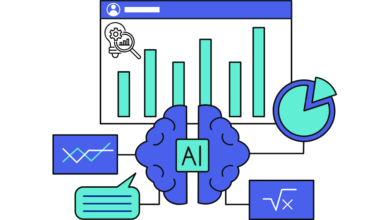
AI model development must prioritize security, privacy, and reliability throughout its lifecycle. As AI’s role expands across industries and daily life, security becomes vital to thwart unauthorized access, data breaches, and other threats.
Prioritizing security helps prevent breaches, safeguard sensitive data, and ensure trustworthy and ethical AI deployment. Discover how to develop and integrate robust security measures to fortify AI systems against emerging risks and ensure their responsible use.
Threats and Vulnerabilities in AI Development
As AI technology advances, so do the threats and vulnerabilities associated with its development. Recent surveys and reports highlight the concerns of cybersecurity experts, with 72% of Chief Information Security Officers (CISOs) believing their organizations are vulnerable to cyber-attacks.
The healthcare industry, in particular, is a prime target for cybercriminals due to the sensitivity of patient data. AI security breaches can have severe consequences. These include cyber-attacks on healthcare organizations, which can expose patient data and result in financial losses.
AI system manipulation might occur, leading to biased decision-making and unfair outcomes. Furthermore, data poisoning will compromise the integrity of AI models and their outputs. AI developers and organizations should prioritize cybersecurity, conduct regular risk assessments, and invest in security solutions to prevent and mitigate these threats.
Security Considerations for AI Models

Developing and deploying AI models necessitates meticulous security measures to avert potential risks and threats. This consideration entails ensuring three things: the confidentiality, integrity, and availability of data and models.
It protects users against unauthorized access, malicious attacks, and other security breaches. Prioritizing security enables organizations to instill trust in their AI systems and uphold the reliability and integrity of their operations.
Data Privacy and Protection
AI models often deal with sensitive data, emphasizing the importance of data privacy and protection. Data anonymization, encryption, and access controls are essential to prevent unauthorized access or breaches.
Compliance with regulations like GDPR and CCPA and the implementation of robust data protection policies are necessary. These steps enable organizations to safeguard sensitive information and maintain trust with their customers.
Model Interpretability and Explainability
Understanding AI decision-making is crucial for trust and reliability. Techniques such as feature attribution and model interpretability offer insights into AI models, helping organizations detect biases and errors.
Explaining the algorithm’s decisions enhances transparency and accountability, fostering trust in AI systems. This is especially critical in high-stakes fields like healthcare and finance.
Robustness and Adversarial Attacks
AI models can be vulnerable to adversarial attacks aiming to manipulate model outputs. Ensuring robustness against these attacks maintains model reliability and prevents potential security breaches.
This includes implementing defensive techniques like adversarial training and input validation. It also includes regularly testing models against conceivable attacks. Organizations can protect their AI systems from potential threats and maintain reliable performance.
Governance and Compliance
Transparent AI governance and compliance policies are necessary for AI development, deployment, and use. Adhering to data privacy laws and intellectual property rights is essential. This requires clear data usage guidelines, transparent AI decision-making, and regular compliance audits, helping organizations avoid legal and reputational risks.
Identity and Access Management
Organizations must restrict access to AI models and data to authorized personnel only. Identity and access management controls prevent unauthorized access, ensuring only those with clearance and need-to-know can access sensitive AI resources.
This involves implementing multi-factor authentication, role-based access control, and regular access reviews. Thus, organizations prevent data breaches and maintain AI system integrity.
Tools and Technologies for Secure AI Development
Various tools and technologies are available to support secure AI development, including guidelines, frameworks, and principles that prioritize security, accountability, and ethical considerations. These resources help organizations develop AI systems that are safe, reliable, and resilient.
NB Defense
A Python library for Neural Network Distillation creates smaller, more robust deep learning models. It enables model compression, improves deployment on edge devices, and enhances model interpretability.
Use cases: Model compression, deployment on edge devices, and improving model interpretability.
Features: Supports popular deep learning frameworks, easy integration, and customizable distillation techniques.
Adversarial Robustness Toolbox
A Python library for experimenting with adversarial examples and improving machine learning model robustness. It provides a comprehensive platform for defending against adversarial attacks, evaluating model security, and developing robust AI systems.
Use cases: Defending against adversarial attacks, evaluating model security, and developing robust AI systems.
Features: Supports multiple attack methods, provides visualization tools, and offers pre-built defense mechanisms.
Garak
An open-source toolkit for identifying and mitigating security vulnerabilities in AI models. It enables secure AI development, model testing, and vulnerability assessment, ensuring the reliability of AI systems.
Use cases: Secure AI development, model testing, and vulnerability assessment.
Features: Supports multiple AI frameworks, provides detailed vulnerability reports, and offers mitigation strategies.
Privacy Meter
An open-source toolkit for measuring the privacy risks of machine learning models. It assesses privacy impact, ensures data protection, and facilitates compliance with regulations, promoting responsible AI development.
Use cases: Privacy impact assessment, data protection, and compliance with regulations.
Features: Supports multiple privacy metrics, provides detailed reports, and offers guidance for mitigation.
Audit A
A Python library for auditing machine learning models for fairness, bias, and security vulnerabilities. It ensures AI accountability by detecting bias, identifying security flaws, and providing mitigation strategies.
Use cases: Model auditing, bias detection, and ensuring AI accountability.
Features: Supports multiple fairness metrics, provides detailed reports, and offers mitigation strategies.
ai-exploits
A collection of open-source tools and libraries for testing machine learning model security. It enables security testing, vulnerability assessment, and development of secure AI systems, promoting trustworthy AI development.
Use cases: Security testing, vulnerability assessment, and developing secure AI systems.
Features: Supports multip
Secure AI Development Lifecycle
The secure AI development lifecycle involves a series of stages that prioritize security, privacy, and reliability throughout the entire AI development process. The following overview is based on industry best practices and guidelines:
Data Collection and Preprocessing
4.4. Data Standardization | Data Preprocessing | Machine Learning Course
Ensure data quality, integrity, and relevance by implementing data validation and verification processes. Implement data anonymization and pseudonymization techniques to protect sensitive information, and conduct regular data security audits and risk assessments to identify and mitigate potential vulnerabilities.
Store data in secure and access-controlled environments, such as encrypted databases or cloud storage.
Model Training and Testing
Use secure and validated datasets for training to prevent data poisoning and other attacks. Implement robust model testing and validation procedures to ensure model accuracy and reliability, and monitor model performance and accuracy to detect potential issues and biases.
Use techniques like adversarial testing to identify potential vulnerabilities and ensure model resilience.
Model Deployment and Monitoring
Deploy models in secure and controlled environments, such as isolated containers or virtual machines, to prevent unauthorized access. Implement robust access controls and authentication mechanisms, such as multi-factor authentication and role-based access control, to ensure only authorized personnel can access and modify models.
Continuously monitor model performance and security, using logging and auditing mechanisms to track model activity and detect potential security breaches, and respond quickly to incidents.
Model Maintenance and Updates
Regularly update and refine models to address new security threats and vulnerabilities, ensuring ongoing security and reliability. Implement version control and change management processes to track changes and ensure accountability, and use techniques like code reviews and testing to validate updates.
This helps prevent introducing new vulnerabilities and ensures models remain secure and effective.
Incident Response and Recovery
Establish incident response and recovery processes to quickly respond to security incidents and minimize damage, ensuring swift action in the event of a breach. Develop a comprehensive incident response plan, including procedures for containing and eradicating threats, notifying stakeholders, and conducting post-incident analysis to improve future response.
Continuous Security Assessment and Testing
Continuously assess and test AI systems for security vulnerabilities and weaknesses, using techniques like penetration testing and red teaming to simulate attacks and identify vulnerabilities.
Regularly conduct security audits and risk assessments to identify areas for improvement, and implement remediation measures to address identified vulnerabilities and weaknesses.
User Education and Awareness
Educate users and stakeholders about AI system security risks and best practices, empowering them to make informed decisions and take appropriate actions to prevent security incidents.
Provide regular training and awareness programs to ensure users understand the latest security threats and mitigations and encourage a security culture throughout the organization. This helps prevent human-error-based security incidents and ensures users are equipped to respond appropriately to security incidents.
Compliance and Regulatory Management
Ensure AI systems comply with relevant regulations and standards (e.g., GDPR, HIPAA, NIST), adhering to legal and industry requirements for security and privacy. Regularly review and update AI systems to ensure ongoing compliance, and conduct audits and assessments to identify and address any gaps or vulnerabilities.
This helps prevent legal and reputational consequences and ensures the organization maintains trust with its customers and stakeholders.
Conclusion
Secure AI model development is crucial for preventing security breaches, protecting sensitive data, and ensuring trustworthy AI deployment. By understanding the threats and vulnerabilities, security considerations, and best practices outlined in this article, organizations can prioritize security and develop AI systems that are reliable, resilient, and secure.
Remember, security is an ongoing process that requires continuous assessment, testing, and improvement to stay ahead of evolving threats. By working together, we can harness the power of AI while minimizing its risks.




